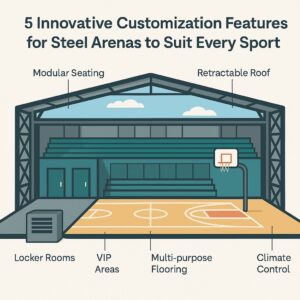Steel arenas are transforming the way sports facilities are designed and utilized. These structures provide the versatility and durability needed to accommodate various sports. From hosting basketball tournaments to soccer matches, a well-designed steel building can maximize space.

A steel building sports complex ensures that different sports and events can be seamlessly integrated into one space. This flexibility allows the complex to host a wide range of events efficiently. In this article, we will explore five innovative customization options that can make a steel arena suitable for a wide range of sports.
1. Modular Seating for Dynamic Viewing Experiences
One key advantage of a steel arena is its ability to incorporate modular seating systems. These adjustable seats can be reconfigured to suit the needs of different events. Whether it’s a basketball game or a concert, modular seating offers flexible arrangements that enhance the fan experience.
In a steel building sports complex, seating can be customized to fit the number of spectators. Additionally, retractable seating can be installed to accommodate varying audience sizes. This customization ensures optimal comfort and viewing for every event.
2. Retractable Roof for Year-Round Use
Reputed providers can offer steel arenas with retractable roof systems that allow the facility to be used in any weather condition. This feature is especially valuable for outdoor sports. The retractable roof can be opened to let in natural sunlight or closed to protect players and spectators from rain, snow, or extreme heat.
This customization ensures that a steel building can host sporting events throughout the year without worrying about weather conditions. The retractable roof also increases the arena’s energy efficiency by allowing natural ventilation when open. When closed, it seals the space, trapping warm or cool air inside.
3. Multi-Purpose Flooring Systems
Another innovative feature in steel arenas is the use of multi-purpose flooring systems. Depending on the flooring system in place, the same facility can easily be adapted for various sports. Customizable flooring allows for easy transitions between events, reducing downtime.
For example, rubberized floors are ideal for basketball and volleyball, while specialized tracks can be installed for running events. In some cases, flooring systems can even be designed to accommodate temporary use. This level of customization helps maximize the steel arena’s functionality for different types of activities.
4. Locker Rooms and VIP Areas for Enhanced Comfort
Steel arenas can also be tailored with dedicated spaces such as locker rooms and VIP areas, ensuring that all athletes have an optimal experience. Custom-designed locker rooms provide players with ample space for preparation, recovery, and relaxation. These areas can be outfitted with top-tier amenities such as high-quality showers, seating, and secure storage for personal items.
VIP areas, on the other hand, can offer a premium experience for sponsors, team owners, and other special guests. These spaces can include plush seating, exclusive access to dining areas, and private suites that provide the best views of the action. This level of customization helps ensure that every guest, from players to VIPs, feels comfortable and valued.
5. Climate Control for Comfort and Performance
Any sports facility must maintain a comfortable environment for players and spectators. Steel arenas can be customized with climate control systems that regulate temperature. A climate control system ensures comfort year-round, maintaining an ideal environment for both players and spectators.
In addition, this can help protect sensitive equipment and products, such as electronics used for timing and scoring. Proper ventilation ensures that the air quality remains high, which is particularly important during significant events. It also safeguards equipment and maintains optimal air quality, which is crucial during significant events.
A steel building sports complex offers unparalleled versatility and durability for a wide range of sports and events. By incorporating them, steel arenas can provide a superior experience for both athletes and spectators. Investing in these innovative features ensures that sports facilities are not only functional but also adaptable to the demands of modern sports.



